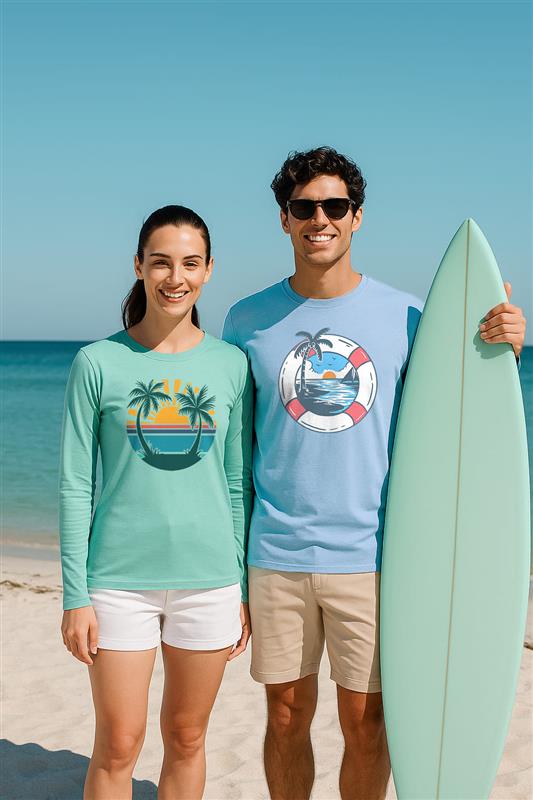The Best UV Hiking Shirt For Your Next Outdoor Adventure

During long hours of hiking, so important to protect yourself from the sun. A UV hiking shirt will feel good on the trail while also protecting your skin from harmful UV rays. Simple t-shirts do not provide proper coverage, making you susceptible to harmful sunburns.
These shirts are tailored using UV rated materials. Breathable, lightweight, and quick-dry, also make these shirts an essential purchase for any avid hiker. UV rated hiking shirts offer protection without excess weight.
Key Points
-
More sun protection than a regular shirt.
-
An optimal shirt has a balance between comfort, fit, and quick-dry capabilities.
-
Following proper care instructions helps hiking shirts last longer.
What Is A UV Hiking Shirt?
A UV hiking shirt is made specifically to safeguard the skin against sun damage while outdoors. These shirts employ specialized fabrics and modern technology to keep you cool and protected while hiking in sunny weather.
Definition And Purpose
A UV hiking shirt is a long—or short-sleeved shirt with ultraviolet (UV) protection to your skin. Shirts look like regular activewear but have added protection in the fabric.
The main objective is to lower your risk of sunburn and skin injury. Hiking or walking outdoors for hours can put you under more sun than expected. Sun damage is even possible on cloudy days because of UV rays.
You wear a hiking shirt to get extra protection without applying sunscreen to every inch of your body. The clothing acts as a shield, something that can be especially helpful for someone who has sensitive skin.
UV Protection Technology
UV hiking shirts use specific materials to stop or absorb UV rays. The most common fibers used are polyester and nylon. These fabrics can be woven tightly to limit sunlight's passage.
Chemical treatments may be added to increase sun protection. Some shirts mix in minerals like titanium dioxide or zinc oxide. These are similar to what you find in some sunscreens but are part of the fabric and do not rub off.
Fabric color can affect how much UV gets blocked. Darker colors usually offer more protection than lighter ones. Construction also matters, with double layers and thicker fabrics blocking more rays.
UPF Ratings Explained
UPF stands for Ultraviolet Protection Factor. It measures how well a fabric blocks out UV rays. The higher the UPF number, the greater the protection your shirt provides.
|
UPF Rating |
% of UV Blocked |
Protection Level |
|
15–24 |
93.3%–95.9% |
Good |
|
25–39 |
96.0%–97.4% |
Very Good |
|
40–50+ |
97.5%–98%+ |
Excellent |
The Real Drawbacks Of Hiking Without Sun Protection
If you go hiking without sun protection, you put your skin at risk. The sun’s rays can be intense, even if you do not feel them immediately.
Here are some common problems you might face:
-
Sunburn: Red, painful skin can happen in less than an hour.
-
Heat rash: Sweat and sun together can block your pores and cause bumps.
-
Dryness: Your skin may get rough or peel from sun exposure.
Potential Health Risks
|
Risk |
What Happens |
|
Sunburn |
Redness, pain, swelling |
|
Dehydration |
Feeling weak, dizzy, or tired |
|
Skin Cancer Risk |
Increased chance over time |
Sometimes, you do not notice the damage until later. UV rays can harm your skin every time you hike without coverage.
A simple long-sleeve or ultraviolet hiking shirt can help prevent most of these problems. It covers more skin, lowering your risk right away.
Remember that cloudy days are not always safe, either. UV rays can still penetrate clouds and cause damage.
4 Things to Consider When Choosing a UV Hiking Shirt
A good hiking shirt is meant to do more than keep you covered. Considering fabric ratings, construction quality, and comfort will enable you to find a shirt that makes you happy and secure.
Certified UPF Protection
Ultraviolet Protection Factor (UPF) rating is the most important rating to seek out on a UV hiking shirt. A UPF of 30 or more provides sufficient solid sun protection. Certified labels or tags usually have this rating—if there is no number, then the shirt probably does not have actual UV blockage.
Materials such as polyester, nylon, and some blends tend to give more UV protection. Cotton, unless specially treated, offers less. It's best to trust known outdoor brands because they usually send their fabrics for proper UPF testing. This ensures your shirt blocks harmful rays as advertised.
A UPF 50 shirt blocks about 98% of UV rays, making it great for long hikes or sunny trails. Checking for certified UPF helps lower the risk of sunburn, even after many hours outdoors.
Lightweight And Breathable Build
The best hiking shirts will never weigh you down. Choose light and airy shirts, especially for summertime hikes or hot climates. More protection is offered by thicker shirts, but overheating is usually the result.
Polyester and nylon materials are ideal for making shirts light yet strong. Mesh panels on the back or under the arms can offer ventilation, keeping you cool as you perspire.
Durable Stitching For Tough Trails
Trails are hard on clothing, so inspect the stitching on any hiking shirt you're looking at. Shirts that feature double-stitched seams or flatlock stitching hold up longer and resist rough pack straps and brush.
Loose threads, thin seams, or one line of stitching tend to translate to reduced shirt life. Firm stitching enables the shirt to retain its form after numerous washes and withstands being stuffed away in a bag or worn multiple days consecutively.
Fast-Drying And Moisture-Wicking
Moisture control is necessary when you have been active for several hours. During a break, a quick-drying shirt prevents you from feeling wet or cold. Polyester and nylon, both synthetic materials, tend to best draw sweat away from your body and dry quickly.
Seek shirts with such labels as "moisture-wicking" or "quick-dry." These assist in transferring sweat to the outside where it can evaporate more readily. Water-holding shirts can cause discomfort, chafing, or even skin issues on multi-day treks.
|
Fabric Type |
Wicks Sweat? |
Dries Fast? |
|
Polyester |
Yes |
Yes |
|
Nylon |
Yes |
Yes |
|
Cotton |
No |
No |
|
Wool |
Somewhat |
Somewhat |
Benefits Of Wearing UV Hiking Shirts
UV hiking shirts help shield your body from sun damage, keep you more comfortable in heat, and let you stay outdoors longer. These shirts use special fabric and design to solve daily problems hikers face.
Skin Protection Against Harmful Rays
Ultraviolet (UV) rays from the sun can cause sunburn, premature skin aging, and raise your risk of skin cancer. Ultraviolet hiking shirts use tightly woven fabrics that block most of these rays. Many shirts also come with a UPF (Ultraviolet Protection Factor) rating, which tells you how much sun rays the shirt will block.
Key features
-
Long sleeves for more coverage.
-
High collars and thumbholes on some designs for extra protection.
-
Light, breathable material to avoid overheating.
Temperature Control
It is easy to overheat on a hike, especially during the summer. Ultraviolet hiking shirts are usually light, moisture-wicking material that pulls sweat off your skin. This keeps you dry and cool because sweat is able to evaporate more efficiently.
These shirts have vents or mesh panels through which air passes freely over your body. The lighter colors also reflect the sun and make you cooler than the darker colors. You will be comfortable even in direct sunlight and when you walk for long hours. These shirts keep you from feeling hot and heavy due to sweaty clothes.
Benefits of UV hiking shirt materials
|
Feature |
Benefit |
|
Moisture-wicking |
Keeps skin dry |
|
Breathable fabric |
Comfort in heat |
|
Quick-drying |
Less chafing |
Extended Outdoor Activity Time
UV hiking shirts can help you stay outside longer without worrying about sunburn or heat stress. Since these shirts protect you from the sun’s rays and help regulate temperature, you are less likely to tire out early or cut your plans short due to discomfort. You may use less sunscreen, and hiking shirts lower the risk of missed spots or uneven coverage. Here are different ways UV hiking shirts extend outdoor time:
-
Reducing sunburn risk.
-
Preventing overheating.
-
Lowering reliance on sunscreen for covered areas.
Why Our UV Hiking Shirt Is A Smart Investment For Hikers
This shirt helps block harmful sun rays, manage sweat, and stay comfortable over long trails. It combines protective materials and useful extras designed for tough journeys. Here are the features of our hiking shirt.
-
Blocks 98% of UV Rays — No Reapplication Necessary
It is rated UPF 50+, which means that it will block up to 98% of both UVA and UVB damaging rays, keeping your skin safe for hours in the sun.
-
Feels Light, Moves Easy — Built for the Trail
As you're hiking on uneven terrain, comfort matters. Our top utilizes light microfiber polyester that is kind to your skin and will not bog you down.
-
Sweat-Wicking Technology
Hiking will often mean sweat, but it doesn't have to mean feeling uncomfortable. The sweat-wicking material pulls sweat from your skin, so you stay dry and comfortable, even on hot, humid days.
-
Quick-Drying & Anti-Odor
No one wishes to complete a hike with a wet, stinky shirt. Our shirt features quick-drying fibers and rapidly releases water and is thus ready for the next part of your journey.
How To Take Care Of UV Hiking Shirts
-
Wash your UV hiking shirt in cold water using a gentle cycle.
-
Use mild detergent. Strong soaps can damage the special UV-blocking fibers.
-
Avoid bleach, fabric softeners, or harsh chemicals.
-
These can break down the fabric and reduce its UV protection.
-
Air dry your shirt to prevent shrinking and keep the fabric strong.
-
Tumble drying on low is usually safe, but high heat can harm the shirt.
-
Check the care label inside the shirt for any special washing instructions.
|
Task |
Recommended Action |
|
Washing |
Cold, gentle cycle |
|
Detergent |
Mild, no bleach or softeners |
|
Drying |
Air dry or low tumble |
|
Storage |
Cool, dry location |
Frequently Asked Questions
What Are The Most Important Features To Consider In A High-Quality UV Hiking Shirt?
Seek out a UPF rating of 30 or more to offer effective protection against the sun. Choose shirts that come with collars and long sleeves to expose less skin.
Dry quickly and wick away moisture so you stay dry on extended walks. Avoid friction with flat seams, and let the vent panels cool you down.
How Does UPF Rating Affect The Effectiveness Of Sun Protection Shirts?
UPF is the Ultraviolet Protection Factor. The greater the UPF, the greater the percentage of UV rays the clothing will prevent from coming into contact with your skin.
A shirt rated at UPF 50 permits only 1/50th of the sun's UV rays to penetrate through, which gives very good protection. A UPF rating lower than 15 is too low for extended outdoor exposure.
What Materials Block UV Best In Hiking Clothes?
The most widely used materials are polyester and nylon since these block more UV radiation naturally than cotton.
Material blends with spandex or elastane can provide additional stretch and comfort. More solid, closer-woven fabric is best for blocking sunlight.
What Makes A UV Hiking Shirt Different From A Regular Hiking Shirt?
A UV hiking shirt is made to block a greater amount of UV rays, usually using specialty coatings or tighter weaves.
Plain hiking shirts may have been optimized only for moisture-wicking or comfort and don't filter much UV light. UV shirts will typically include a noted UPF rating on the tag itself.


